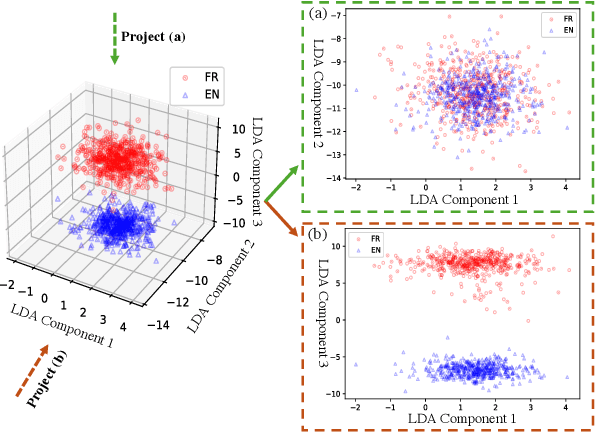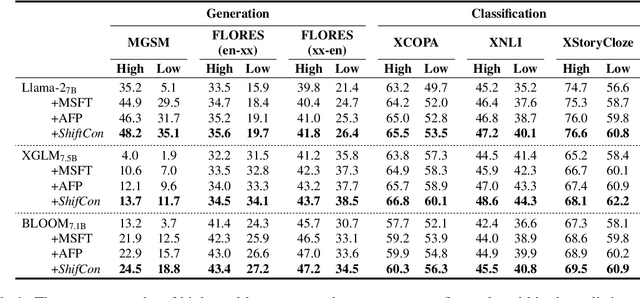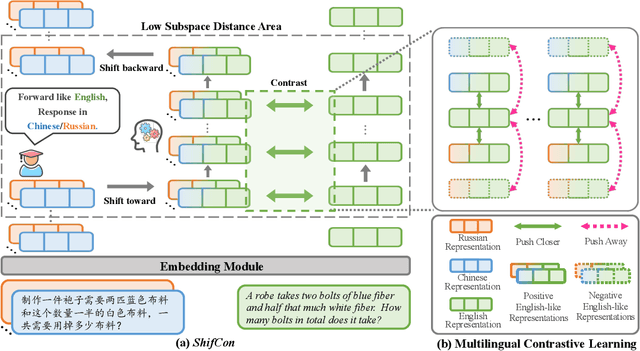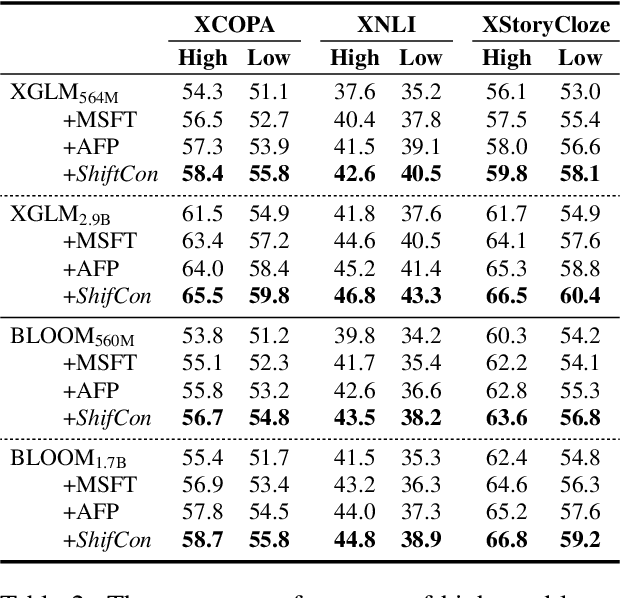Sizhe Wang
CodeFlowBench: A Multi-turn, Iterative Benchmark for Complex Code Generation
Apr 30, 2025Abstract:Real world development demands code that is readable, extensible, and testable by organizing the implementation into modular components and iteratively reuse pre-implemented code. We term this iterative, multi-turn process codeflow and introduce CodeFlowBench, the first benchmark designed for comprehensively evaluating LLMs' ability to perform codeflow, namely to implement new functionality by reusing existing functions over multiple turns. CodeFlowBench comprises 5258 problems drawn from Codeforces and is continuously updated via an automated pipeline that decomposes each problem into a series of function-level subproblems based on its dependency tree and each subproblem is paired with unit tests. We further propose a novel evaluation framework with tasks and metrics tailored to multi-turn code reuse to assess model performance. In experiments across various LLMs under both multi-turn and single-turn patterns. We observe models' poor performance on CodeFlowBench, with a substantial performance drop in the iterative codeflow scenario. For instance, o1-mini achieves a pass@1 of 20.8% in multi-turn pattern versus 37.8% in single-turn pattern. Further analysis shows that different models excel at different dependency depths, yet all struggle to correctly solve structurally complex problems, highlighting challenges for current LLMs to serve as code generation tools when performing codeflow. Overall, CodeFlowBench offers a comprehensive benchmark and new insights into LLM capabilities for multi-turn, iterative code generation, guiding future advances in code generation tasks.
A multi-scale vision transformer-based multimodal GeoAI model for mapping Arctic permafrost thaw
Apr 23, 2025Abstract:Retrogressive Thaw Slumps (RTS) in Arctic regions are distinct permafrost landforms with significant environmental impacts. Mapping these RTS is crucial because their appearance serves as a clear indication of permafrost thaw. However, their small scale compared to other landform features, vague boundaries, and spatiotemporal variation pose significant challenges for accurate detection. In this paper, we employed a state-of-the-art deep learning model, the Cascade Mask R-CNN with a multi-scale vision transformer-based backbone, to delineate RTS features across the Arctic. Two new strategies were introduced to optimize multimodal learning and enhance the model's predictive performance: (1) a feature-level, residual cross-modality attention fusion strategy, which effectively integrates feature maps from multiple modalities to capture complementary information and improve the model's ability to understand complex patterns and relationships within the data; (2) pre-trained unimodal learning followed by multimodal fine-tuning to alleviate high computing demand while achieving strong model performance. Experimental results demonstrated that our approach outperformed existing models adopting data-level fusion, feature-level convolutional fusion, and various attention fusion strategies, providing valuable insights into the efficient utilization of multimodal data for RTS mapping. This research contributes to our understanding of permafrost landforms and their environmental implications.
Bootstrapped Model Predictive Control
Mar 24, 2025Abstract:Model Predictive Control (MPC) has been demonstrated to be effective in continuous control tasks. When a world model and a value function are available, planning a sequence of actions ahead of time leads to a better policy. Existing methods typically obtain the value function and the corresponding policy in a model-free manner. However, we find that such an approach struggles with complex tasks, resulting in poor policy learning and inaccurate value estimation. To address this problem, we leverage the strengths of MPC itself. In this work, we introduce Bootstrapped Model Predictive Control (BMPC), a novel algorithm that performs policy learning in a bootstrapped manner. BMPC learns a network policy by imitating an MPC expert, and in turn, uses this policy to guide the MPC process. Combined with model-based TD-learning, our policy learning yields better value estimation and further boosts the efficiency of MPC. We also introduce a lazy reanalyze mechanism, which enables computationally efficient imitation learning. Our method achieves superior performance over prior works on diverse continuous control tasks. In particular, on challenging high-dimensional locomotion tasks, BMPC significantly improves data efficiency while also enhancing asymptotic performance and training stability, with comparable training time and smaller network sizes. Code is available at https://github.com/wertyuilife2/bmpc.
Prithvi-EO-2.0: A Versatile Multi-Temporal Foundation Model for Earth Observation Applications
Dec 03, 2024Abstract:This technical report presents Prithvi-EO-2.0, a new geospatial foundation model that offers significant improvements over its predecessor, Prithvi-EO-1.0. Trained on 4.2M global time series samples from NASA's Harmonized Landsat and Sentinel-2 data archive at 30m resolution, the new 300M and 600M parameter models incorporate temporal and location embeddings for enhanced performance across various geospatial tasks. Through extensive benchmarking with GEO-Bench, the 600M version outperforms the previous Prithvi-EO model by 8\% across a range of tasks. It also outperforms six other geospatial foundation models when benchmarked on remote sensing tasks from different domains and resolutions (i.e. from 0.1m to 15m). The results demonstrate the versatility of the model in both classical earth observation and high-resolution applications. Early involvement of end-users and subject matter experts (SMEs) are among the key factors that contributed to the project's success. In particular, SME involvement allowed for constant feedback on model and dataset design, as well as successful customization for diverse SME-led applications in disaster response, land use and crop mapping, and ecosystem dynamics monitoring. Prithvi-EO-2.0 is available on Hugging Face and IBM terratorch, with additional resources on GitHub. The project exemplifies the Trusted Open Science approach embraced by all involved organizations.
Enhancing GeoAI and location encoding with spatial point pattern statistics: A Case Study of Terrain Feature Classification
Nov 21, 2024Abstract:This study introduces a novel approach to terrain feature classification by incorporating spatial point pattern statistics into deep learning models. Inspired by the concept of location encoding, which aims to capture location characteristics to enhance GeoAI decision-making capabilities, we improve the GeoAI model by a knowledge driven approach to integrate both first-order and second-order effects of point patterns. This paper investigates how these spatial contexts impact the accuracy of terrain feature predictions. The results show that incorporating spatial point pattern statistics notably enhances model performance by leveraging different representations of spatial relationships.
BPO: Towards Balanced Preference Optimization between Knowledge Breadth and Depth in Alignment
Nov 16, 2024Abstract:Reinforcement Learning with Human Feedback (RLHF) is the key to the success of large language models (LLMs) in recent years. In this work, we first introduce the concepts of knowledge breadth and knowledge depth, which measure the comprehensiveness and depth of an LLM or knowledge source respectively. We reveal that the imbalance in the number of prompts and responses can lead to a potential disparity in breadth and depth learning within alignment tuning datasets by showing that even a simple uniform method for balancing the number of instructions and responses can lead to significant improvements. Building on this, we further propose Balanced Preference Optimization (BPO), designed to dynamically augment the knowledge depth of each sample. BPO is motivated by the observation that the usefulness of knowledge varies across samples, necessitating tailored learning of knowledge depth. To achieve this, we introduce gradient-based clustering, estimating the knowledge informativeness and usefulness of each augmented sample based on the model's optimization direction. Our experimental results across various benchmarks demonstrate that BPO outperforms other baseline methods in alignment tuning while maintaining training efficiency. Furthermore, we conduct a detailed analysis of each component of BPO, providing guidelines for future research in preference data optimization.
ShifCon: Enhancing Non-Dominant Language Capabilities with a Shift-based Contrastive Framework
Oct 25, 2024



Abstract:Although fine-tuning Large Language Models (LLMs) with multilingual data can rapidly enhance the multilingual capabilities of LLMs, they still exhibit a performance gap between the dominant language (e.g., English) and non-dominant ones due to the imbalance of training data across languages. To further enhance the performance of non-dominant languages, we propose ShifCon, a Shift-based Contrastive framework that aligns the internal forward process of other languages toward that of the dominant one. Specifically, it shifts the representations of non-dominant languages into the dominant language subspace, allowing them to access relatively rich information encoded in the model parameters. The enriched representations are then shifted back into their original language subspace before generation. Moreover, we introduce a subspace distance metric to pinpoint the optimal layer area for shifting representations and employ multilingual contrastive learning to further enhance the alignment of representations within this area. Experiments demonstrate that our ShifCon framework significantly enhances the performance of non-dominant languages, particularly for low-resource ones. Further analysis offers extra insights to verify the effectiveness of ShifCon and propel future research
The KnowWhereGraph Ontology
Oct 17, 2024



Abstract:KnowWhereGraph is one of the largest fully publicly available geospatial knowledge graphs. It includes data from 30 layers on natural hazards (e.g., hurricanes, wildfires), climate variables (e.g., air temperature, precipitation), soil properties, crop and land-cover types, demographics, and human health, various place and region identifiers, among other themes. These have been leveraged through the graph by a variety of applications to address challenges in food security and agricultural supply chains; sustainability related to soil conservation practices and farm labor; and delivery of emergency humanitarian aid following a disaster. In this paper, we introduce the ontology that acts as the schema for KnowWhereGraph. This broad overview provides insight into the requirements and design specifications for the graph and its schema, including the development methodology (modular ontology modeling) and the resources utilized to implement, materialize, and deploy KnowWhereGraph with its end-user interfaces and public query SPARQL endpoint.
Geospatial foundation models for image analysis: evaluating and enhancing NASA-IBM Prithvi's domain adaptability
Aug 31, 2024Abstract:Research on geospatial foundation models (GFMs) has become a trending topic in geospatial artificial intelligence (AI) research due to their potential for achieving high generalizability and domain adaptability, reducing model training costs for individual researchers. Unlike large language models, such as ChatGPT, constructing visual foundation models for image analysis, particularly in remote sensing, encountered significant challenges such as formulating diverse vision tasks into a general problem framework. This paper evaluates the recently released NASA-IBM GFM Prithvi for its predictive performance on high-level image analysis tasks across multiple benchmark datasets. Prithvi was selected because it is one of the first open-source GFMs trained on time-series of high-resolution remote sensing imagery. A series of experiments were designed to assess Prithvi's performance as compared to other pre-trained task-specific AI models in geospatial image analysis. New strategies, including band adaptation, multi-scale feature generation, and fine-tuning techniques, are introduced and integrated into an image analysis pipeline to enhance Prithvi's domain adaptation capability and improve model performance. In-depth analyses reveal Prithvi's strengths and weaknesses, offering insights for both improving Prithvi and developing future visual foundation models for geospatial tasks.
Optimizing Language Model's Reasoning Abilities with Weak Supervision
May 07, 2024



Abstract:While Large Language Models (LLMs) have demonstrated proficiency in handling complex queries, much of the past work has depended on extensively annotated datasets by human experts. However, this reliance on fully-supervised annotations poses scalability challenges, particularly as models and data requirements grow. To mitigate this, we explore the potential of enhancing LLMs' reasoning abilities with minimal human supervision. In this work, we introduce self-reinforcement, which begins with Supervised Fine-Tuning (SFT) of the model using a small collection of annotated questions. Then it iteratively improves LLMs by learning from the differences in responses from the SFT and unfinetuned models on unlabeled questions. Our approach provides an efficient approach without relying heavily on extensive human-annotated explanations. However, current reasoning benchmarks typically only include golden-reference answers or rationales. Therefore, we present \textsc{PuzzleBen}, a weakly supervised benchmark that comprises 25,147 complex questions, answers, and human-generated rationales across various domains, such as brainteasers, puzzles, riddles, parajumbles, and critical reasoning tasks. A unique aspect of our dataset is the inclusion of 10,000 unannotated questions, enabling us to explore utilizing fewer supersized data to boost LLMs' inference capabilities. Our experiments underscore the significance of \textsc{PuzzleBen}, as well as the effectiveness of our methodology as a promising direction in future endeavors. Our dataset and code will be published soon on \texttt{Anonymity Link}.
 Add to Chrome
Add to Chrome Add to Firefox
Add to Firefox Add to Edge
Add to Edge